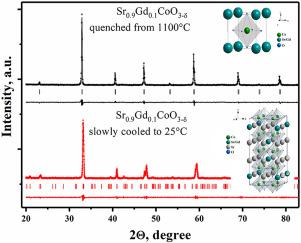当前位置:
X-MOL 学术
›
Solid State Sci.
›
论文详情
Our official English website, www.x-mol.net, welcomes your
feedback! (Note: you will need to create a separate account there.)
Crystal Structure, Oxygen Content and Conductivity of Sr1-Gd CoO3-δ
Solid State Sciences ( IF 3.4 ) Pub Date : 2020-12-01 , DOI: 10.1016/j.solidstatesciences.2020.106453 A.V. Maklakova , A.S. Baten'kova , M.A. Vlasova , N.E. Volkova , L. Ya. Gavrilova , V.A. Cherepanov
Solid State Sciences ( IF 3.4 ) Pub Date : 2020-12-01 , DOI: 10.1016/j.solidstatesciences.2020.106453 A.V. Maklakova , A.S. Baten'kova , M.A. Vlasova , N.E. Volkova , L. Ya. Gavrilova , V.A. Cherepanov

|
Abstract Solid solutions Sr1–xGdxCoO3–δ (0.0≤x≤0.4) were synthesized through a glycerol-nitrate technique. The final anneals were performed at 1100°C in air for 120 h. All the samples were slowly cooled to room temperature at a rate of about 100 °C/h; alternatively, they were quenched to room temperature at a cooling rate of about 500 °/min. The structural parameters of all the samples were refined via Rietveld analysis. All the single-phase oxides slowly cooled to room temperature in air possess a tetragonal 2ap×2ap×4ap superstructure (sp. gr. I4/mmm). Only Sr0.9Gd0.1CoO3–δ undergoes a complete order-disorder type phase transition: heating it up to 1100oC in air transforms it from an ordered tetragonal 2ap×2ap×4ap structure to a disordered cubic structure. The super-structural lines for Sr0.9Gd0.1CoO3–δ noticeably decreased at 1100 oC, but are still present in the XRD pattern. The structure of Sr1–xGdxCoO3–δ with x=0.3 and 0.4 at 1100 oC remains almost unchanged. The oxygen content in Sr1–xGdxCoO3–δ at room temperature ranges from δ=2.57 in the sample with x=0.1 to δ=2.75 in the sample with x=0.4. The variations in oxygen content, electrical conductivity and the Seebeck coefficient in the Sr1–xGdxCoO3–δ oxides were measured in air versus temperature. The temperature dependences of conductivity for Sr1-xGdxCoO3-δ exhibit maximum (∼550 S/cm) at 300-400°C. The conductivity values depend weakly on the Gd content in Sr1–xGdxCoO3–δ. The temperature dependences of the Seebeck coefficient (S) for all oxides are represented by smooth curves with minimum. The positive S values at room temperature (12 – 36 μV/K) decreased down to zero or even tiny negative values (– 3 μV/K) as the temperate rose within the range of 300-800°C and they then rose slightly to 2-14 μV/K at 1100°C.
中文翻译:

Sr1-Gd CoO3-δ的晶体结构、氧含量和电导率
摘要 通过甘油-硝酸盐技术合成了固溶体Sr1–xGdxCoO3–δ (0.0≤x≤0.4)。最终退火在 1100°C 空气中进行 120 小时。将所有样品以约100℃/h的速率缓慢冷却至室温;或者,它们以约 500°/min 的冷却速率淬火至室温。所有样品的结构参数均通过 Rietveld 分析进行细化。所有在空气中缓慢冷却至室温的单相氧化物都具有四方 2ap×2ap×4ap 超结构(sp. gr. I4/mmm)。只有 Sr0.9Gd0.1CoO3-δ 经历了完整的有序-无序型相变:在空气中加热到 1100oC,它会从有序的四方 2ap×2ap×4ap 结构转变为无序立方结构。Sr0.9Gd0.1CoO3-δ 的超结构线在 1100 oC 时明显减少,但仍存在于 XRD 图中。Sr1–xGdxCoO3–δ 的结构在 1100 oC 时 x=0.3 和 0.4 几乎保持不变。室温下 Sr1–xGdxCoO3–δ 中的氧含量范围从 x=0.1 的样品中的 δ=2.57 到 x=0.4 的样品中的 δ=2.75。在空气中测量了 Sr1-xGdxCoO3-δ 氧化物中氧含量、电导率和塞贝克系数的变化与温度的关系。Sr1-xGdxCoO3-δ 的电导率的温度依赖性在 300-400°C 时表现出最大值 (~550 S/cm)。电导率值与 Sr1–xGdxCoO3–δ 中 Gd 的含量有微弱的关系。所有氧化物的塞贝克系数 (S) 的温度依赖性由具有最小值的平滑曲线表示。
更新日期:2020-12-01
中文翻译:

Sr1-Gd CoO3-δ的晶体结构、氧含量和电导率
摘要 通过甘油-硝酸盐技术合成了固溶体Sr1–xGdxCoO3–δ (0.0≤x≤0.4)。最终退火在 1100°C 空气中进行 120 小时。将所有样品以约100℃/h的速率缓慢冷却至室温;或者,它们以约 500°/min 的冷却速率淬火至室温。所有样品的结构参数均通过 Rietveld 分析进行细化。所有在空气中缓慢冷却至室温的单相氧化物都具有四方 2ap×2ap×4ap 超结构(sp. gr. I4/mmm)。只有 Sr0.9Gd0.1CoO3-δ 经历了完整的有序-无序型相变:在空气中加热到 1100oC,它会从有序的四方 2ap×2ap×4ap 结构转变为无序立方结构。Sr0.9Gd0.1CoO3-δ 的超结构线在 1100 oC 时明显减少,但仍存在于 XRD 图中。Sr1–xGdxCoO3–δ 的结构在 1100 oC 时 x=0.3 和 0.4 几乎保持不变。室温下 Sr1–xGdxCoO3–δ 中的氧含量范围从 x=0.1 的样品中的 δ=2.57 到 x=0.4 的样品中的 δ=2.75。在空气中测量了 Sr1-xGdxCoO3-δ 氧化物中氧含量、电导率和塞贝克系数的变化与温度的关系。Sr1-xGdxCoO3-δ 的电导率的温度依赖性在 300-400°C 时表现出最大值 (~550 S/cm)。电导率值与 Sr1–xGdxCoO3–δ 中 Gd 的含量有微弱的关系。所有氧化物的塞贝克系数 (S) 的温度依赖性由具有最小值的平滑曲线表示。









































 京公网安备 11010802027423号
京公网安备 11010802027423号